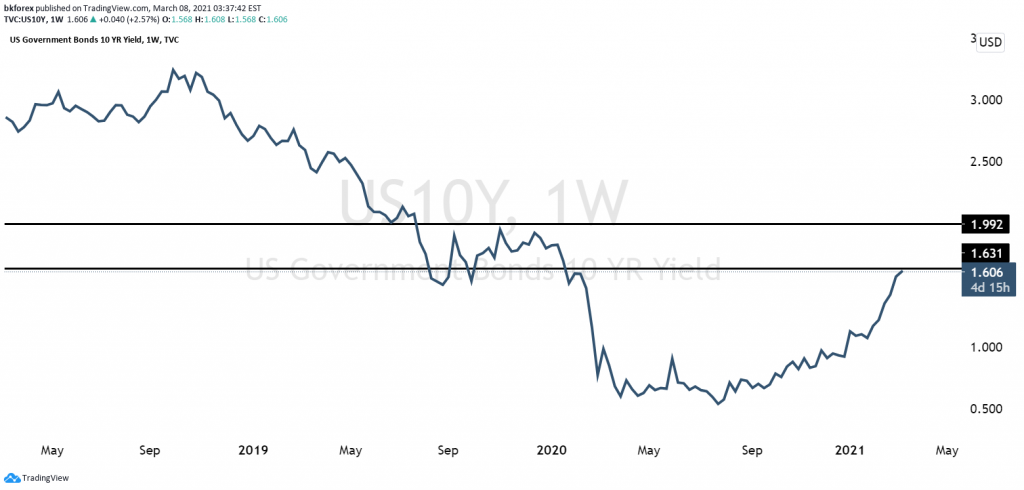
- For the first time in decades market is concerned about inflation
- Is this a temporary or persistent problem?
- CPI and Treasury auctions once again the focus of markets
- Watch the gap between nominal and core inflation readings
- Danger for Fed of a negative feedback loop
The central driving theme of markets since the start of the year has been the relentless rally in US yields. The benchmark 10 year rate which bottomed at 37 basis points during the peak of COVID panic now stands near a 52 week high of 160 basis points in the wake of last Friday’s blockbuster Non-Farm payrolls results.
For the first time in decades market is concerned about inflation
For the first time in years the market is worried about the prospect of persistent inflation as the combination of rebound in growth and government largesse puts upward pressure on demand, The Senate passage over the weekend of President Biden’s 1.9 Billion stimulus bill will only stoke the fears of inflationistas who like modern day Cassandras have been warning that the Fed is about to lose control of monetary policy.
Is this a temporary or persistent problem?
Whether inflation fears are justified or not remains to be seen. It’s difficult to tell if the current rise in commodity prices is more a function of temporary supply chain disruptions or a truly structural issue that could have longer more lasting implications on price levels. The dominant story of the past twenty years has been the inexorable deflationary effect of technology on every aspect of economic life. That dynamic remains in place and is likely to remain a strong counter weight to the inflation argument, especially now that COVID has shown the powerful deflationary impact of technology on services as well. ZOOM weddings, ZOOM funerals, ZOOM business meetings and ZOOM doctor visits, may diminish in their frequency once everyone is vaccinated but they will not go away and entirely. In fact it is almost certain that this technology will improve pushing service costs ever lower.
Nevertheless for now the narrative has shifted squarely towards inflation fears and economic calendar events that haven’t mattered for more than a decade will now take center stage in investor’s psyches. This week two key releases could wreak havoc in the markets if they begin to confirm the inflation thesis.
CPI and Treasury auctions once again the focus of markets
The market will get a look at both the CPI and PPI readings on Wednesday and Friday as well as the 10 year and the 30 year bond auction in the later half of the week. The CPI reading ex-Food and energy is expected to remain muted at 1.4% annual rate, but if the full CPI reading which is forecast to print at 1.7% comes in closer to 2% the reaction in the capital markets is likely to be swift and brutal. Despite policymakers focus on the core readings if the gap between nominal and core inflation data widens to 50 basis points or more the markets will panic anticipating that sharp rise in commodity prices will eventually make its way into the price level readings. Furthermore, a poor CPI print will no doubt dampen demand for Treasury paper pushing rates higher.

Danger for Fed of a negative feedback loop
This in turn creates a vicious cycle for policy makers. Higher rates means higher debt service costs for the US budget which in turn generates even higher budget deficits which in turn makes investors even less interested in long term paper and drives rates even higher.
For now we are only seeing the rumbling of a possible rebellion in rates as markets continue to digest the data and assess the risks, but one thing is certain. After years of being ignored inflation data and auction results will now become key market obsessions.





